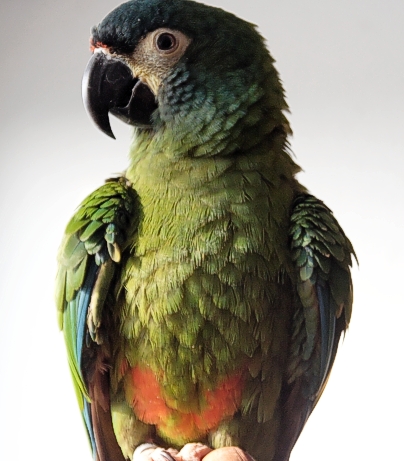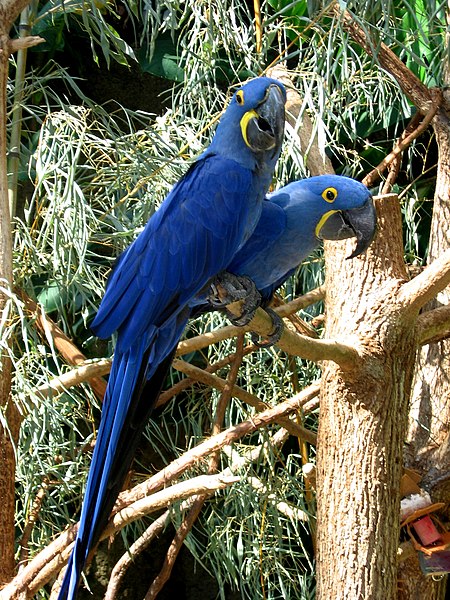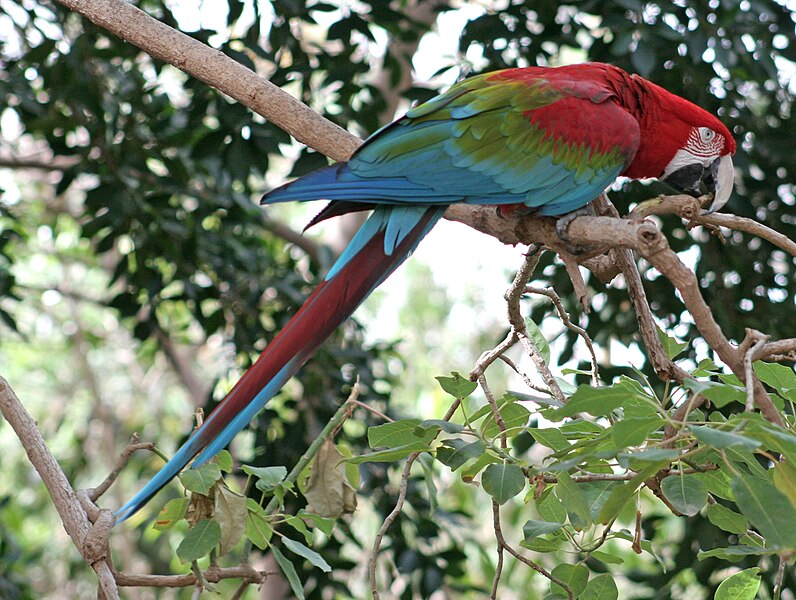 The 56 lory and lorikeet species are among the most gorgeous and active of all parrots, and are usually quite bold in character. In both the wild (particularly Australia) and in zoos, lory feeding stations are a great hit with tourists, with hundreds of colorful birds flocking onto treat-bearing visitors.
The 56 lory and lorikeet species are among the most gorgeous and active of all parrots, and are usually quite bold in character. In both the wild (particularly Australia) and in zoos, lory feeding stations are a great hit with tourists, with hundreds of colorful birds flocking onto treat-bearing visitors.
The Effect of Feeding Ecology
Lory and lorikeets rely primarily upon a relatively scarce, widely-scattered food source – pollen and nectar, and herein lays the explanation for their aggressive feeding behavior. Competition at feeding sites has fostered in these birds a repertoire of over 30 threat displays…a far greater number than is seen in other parrots. Unfortunately, these tendencies often express themselves as aggressive behaviors in captivity, with even long-paired birds sometimes running into difficulties.
Space and Aggression
A change in the environment is frequently a pre-cursor to aggression. Giving the birds more room – a great concept in principal – often leads to fighting. This is true for many birds (and other animals)…I once lost 2 white-crested laughing jay thrushes to aggression after giving birds that had lived peaceably together for 18 month access to an adjoining cage. Of course, crowding can also lead to fights, but the possibility of extending or establishing a territory seems an especially strong factor. Lories seem particularly prone to this phenomenon.
Adding a Nest Box
The provision of a nest box may bring on breeding-related aggression in an otherwise peaceful male, and moving even a long-established pair to a new cage is always a cause for concern. Be sure to observe your birds carefully at such times, and separate them if you will be away for long periods when the change is first instituted.
Introducing Birds
Introduce new birds by caging them side-by-side, and confine a possibly troublesome individual to a small cage or carrier within the larger cage, if space permits, to allow the birds to get used to each other. I relied upon this method with a wide variety of birds in zoo situations, and found it most useful. If using a carrier for the introduction, choose one with barred as opposed to solid sides, so that the birds can interact. Pets International Take Me Home Traveler is ideal.
Other Considerations
Limiting mobility by clipping the wings of aggressive birds is another tried and proven method of easing the introduction process. The availability of a wide variety of bird toys and a complex, well-perched cage will go a long way in keeping your birds occupied with constructive (rather than destructive!) activities. Of course, proper lory nutrition is essential in fostering normal behavior and good relations among your pets.
Please also see my article on lory and lorikeet feeding behavior and natural history:
Lories and Lorikeets – why do they differ so from other parrots?
Image referenced from Wikipedia.
 That Bird Blog – Bird Care and History for Pet Birds
That Bird Blog – Bird Care and History for Pet Birds

 The two parrot species known as caiques (pronounced “kai-EKE) have not, until recently, been very popular in the pet trade. In fact, my introduction to both came about as a result of caring for several that were part of the Bronx Zoo’s collection, despite prior experience working for a large bird importer. Their outgoing personalities, unique markings and non-stop antics have now brought them out of the avicultural shadows, and their popularity is on the rise.
The two parrot species known as caiques (pronounced “kai-EKE) have not, until recently, been very popular in the pet trade. In fact, my introduction to both came about as a result of caring for several that were part of the Bronx Zoo’s collection, despite prior experience working for a large bird importer. Their outgoing personalities, unique markings and non-stop antics have now brought them out of the avicultural shadows, and their popularity is on the rise. The two described caique species (and 5 subspecies) seem unrelated to other South American parrots. Both are stocky in build and present quite a unique appearance in terms of color – bright green backs and wings with white breasts and, depending upon the species, a black or yellow-orange head. At 9 inches in length, they are just the right size for those with limited space…please note, however, that caiques are quite active and need a roomier cage than their size might indicate, or daily out-of-cage exercise.
The two described caique species (and 5 subspecies) seem unrelated to other South American parrots. Both are stocky in build and present quite a unique appearance in terms of color – bright green backs and wings with white breasts and, depending upon the species, a black or yellow-orange head. At 9 inches in length, they are just the right size for those with limited space…please note, however, that caiques are quite active and need a roomier cage than their size might indicate, or daily out-of-cage exercise. This charming bird’s unfortunate Latin name conjures up the image of a stern creature, which is not at all accurate. The largest of the “miniature macaws”, the 20 inch long severe is playful, affectionate and a potentially skilled talker.
This charming bird’s unfortunate Latin name conjures up the image of a stern creature, which is not at all accurate. The largest of the “miniature macaws”, the 20 inch long severe is playful, affectionate and a potentially skilled talker.

 The gray parrot may be found across the breadth of central Africa, along, above and below the equator, and on islands in the Gulf of Guinea. The huge range extends from Guinea Bissau on the west coast to Cameroon and continues southeast to Kenya in East Africa and south to northern Angola. Three subspecies have been described, but there are questions as to their validity.
The gray parrot may be found across the breadth of central Africa, along, above and below the equator, and on islands in the Gulf of Guinea. The huge range extends from Guinea Bissau on the west coast to Cameroon and continues southeast to Kenya in East Africa and south to northern Angola. Three subspecies have been described, but there are questions as to their validity. At 40 inches in length and sporting a wingspan of nearly 5 feet, this giant of the group is also the world’s largest parrot. Words cannot do justice to its plumage, which is deep cobalt blue in color, highlighted by golden yellow about the eyes and lower mandible.
At 40 inches in length and sporting a wingspan of nearly 5 feet, this giant of the group is also the world’s largest parrot. Words cannot do justice to its plumage, which is deep cobalt blue in color, highlighted by golden yellow about the eyes and lower mandible. Although smaller than the hyacinth, this 3 foot-long beauty is still quite an impressive bird. With its particularly affectionate personality, playful ways and impressive speaking ability, the blue-and-gold is perhaps the best of the large macaws with which to start. Huge imports in the 1960’s and 70’s allowed the establishment of many breeding groups, and today it is the least expensive and most widely-kept macaw in the USA.
Although smaller than the hyacinth, this 3 foot-long beauty is still quite an impressive bird. With its particularly affectionate personality, playful ways and impressive speaking ability, the blue-and-gold is perhaps the best of the large macaws with which to start. Huge imports in the 1960’s and 70’s allowed the establishment of many breeding groups, and today it is the least expensive and most widely-kept macaw in the USA. Often mistaken for a scarlet macaw, the green-wing is a larger bird, nearly the size of a hyacinth, and is clad in a deeper burgundy red than is its more commonly-kept cousin. It is also an easier bird to manage than the scarlet, being quite gentle and very playful. My first long-ago experience with hand raised green-wings remains sharp today…rolling on their backs and pawing at me, they acted more like kittens than birds! Green wings are, however, very sensitive birds, and are easily upset by strangers or sudden noises. Their beaks are out-sized, even by macaw standards, and lend them a comical air.
Often mistaken for a scarlet macaw, the green-wing is a larger bird, nearly the size of a hyacinth, and is clad in a deeper burgundy red than is its more commonly-kept cousin. It is also an easier bird to manage than the scarlet, being quite gentle and very playful. My first long-ago experience with hand raised green-wings remains sharp today…rolling on their backs and pawing at me, they acted more like kittens than birds! Green wings are, however, very sensitive birds, and are easily upset by strangers or sudden noises. Their beaks are out-sized, even by macaw standards, and lend them a comical air.